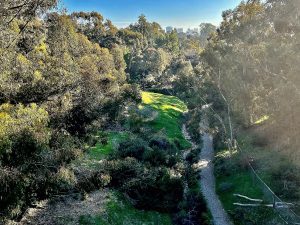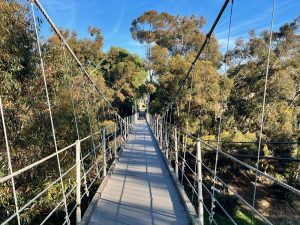
Our exploration of urban canyons in Uptown neighborhoods this time around is Arroyo Canyon,

a small trail tucked behind a private residential area. After enjoying a lunch of enchiladas and a couple cups of cinnamon-infused Café Olla at Jimmy Carter’s, we went for a walk. Going west on Spruce Street to the corner of Front Street, we saw the Spruce Street swinging bridge, called the “wiggly bridge” when it was built in 1912.

It takes a bit of an adventuresome spirit to master the art of walking the first time on the 375-foot long pedestrian bridge. Supported by cables embedded in concrete slabs beneath the soil, the bridge suspends over Arroyo Canyon. A strong wind, a rowdy bunch of people, or just walking a bit unsteadily can make it swing just enough to cause a bit of vertigo for people even with the best balance. But it should be on everyone’s bucket list of things to do in San Diego.
Engineered by Edwin Capps, the footbridge was initially designed to provide pedestrians a passage across the canyon in order to get between the streetcar trolley lines on Fourth and Fifth Avenue. It has stayed in place ever since— long after the trolley was removed from Uptown’s cityscape. Now the bridge is still a best-kept secret to many San Diegans.
After we had ventured across and back the swinging bridge, gazing down at the Arroyo Canyon trail meandering underneath, we made it our mission to explore the trail.

We drove to Laurel Street, heading down the steep-banked hill to State Street. There we turned right and turned a couple of blocks down at Arroyo Street. At the corner of Arroyo and Dove streets, we bore left where Arroyo turns into North Arroyo Street.
This is where it got tricky. At the end of North Arroyo Street is a driveway with a sign announcing Arroyo Canyon Private Residences. Fortunately, we came across another walker; she was familiar with the neighborhood. She told us to park along that long block and then walk up the long blacktop driveway until we came the first major right hand turn. That is where we turned.
It is always amazing how quiet and sheltered these urban canyons can be. It is no different for Arroyo Canyon.
“It’s like a private forest in here,” said the woman who helped us find it.

Indeed, it is. Eucalyptus trees reach up to forever. A dry stream bed filled with river rocks runs alongside the trail. Laurel Sumac, Lemonade Berry and Castor Bean abound.
About halfway down the trail, you’ll encounter the swinging Spruce Street Bridge seventy feet above. The vertigo-inducing bridge is quite a spectacle from beneath, invoking a new respect for yourself and others who walk across the bridge. A cool breeze sifts along the canyon’s quarter-mile run. At the trail’s end, you will find a padlocked metal fence protecting a private property.

After gazing upward at the eucalyptus tree castles and taking in a full breath of the perfumed air, it is time to turn around and follow the trail back down. It is a perfect time to reflect on the vision of San Diego city planners—as well as volunteers—to conserve these canyons as an important part of San Diego enrichment.
More than 200 canyons in San Diego are available as open, hikeable space to the public under San Diego’s Open Space Division. These canyons are all part of the watershed system delivering water from the mountains and urban landscape to the oceans. They are just as beneficial for community recreational use as they are for water quality filtration. Through the help of dedicated volunteers, formerly trashed-out canyons are transformed into areas for sustainable use. Local non-profit groups collaborate their efforts with San Diego Parks and Recreation. Some of these groups include: San Diego Canyonlands; I Love a Clean San Diego; San Diego Audubon Society and Sierra Club San Diego Chapter.
Next time, we will explore a trail in Mission Hills near a historic park.









